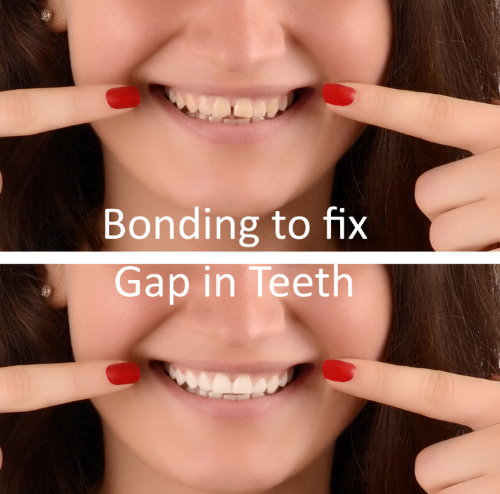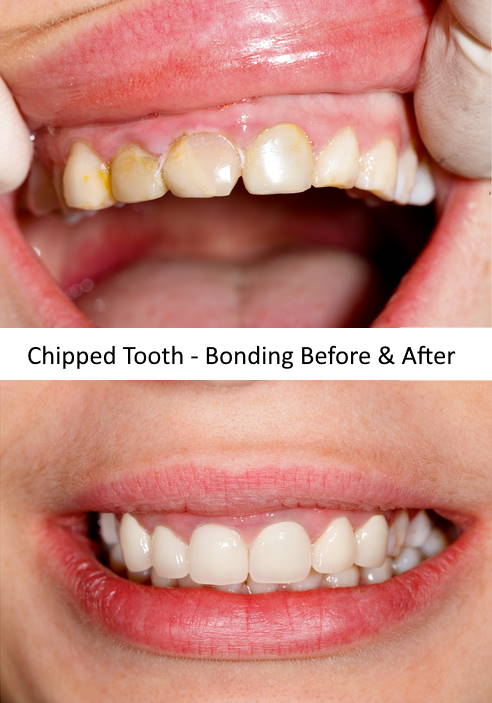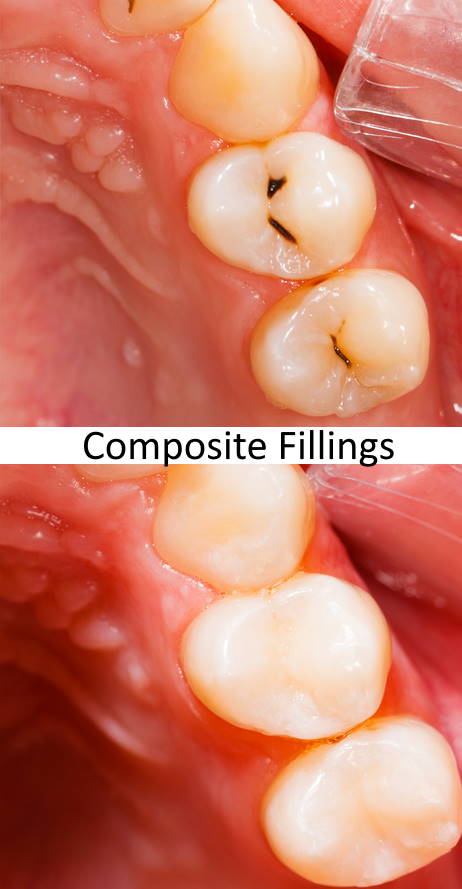There are several cosmetic procedures that can fix a chipped or discolored tooth. Among those, tooth bonding is the easiest and least expensive. This type of cosmetic treatment can quickly repair your damaged tooth and restore its color and appearance, ultimately resulting in a better and more radiant smile.
Contents: What is Tooth Bonding? | Who is a good candidate? | Pros and Cons | Types | Procedure | How much is dental bonding? | Appointment | FAQs
What is Teeth Bonding?
 Tooth bonding, also called Dental Bonding, is a kind of cosmetic treatment that uses a tooth-colored composite resin to fix oral problems such as a cracked tooth, weakened tooth, tooth gaps, discolored tooth as well as alter the tooth’s shape. In some cases, it is also used to fill in the cavity of a decayed tooth. The resin material is put on the affected tooth and is hardened by a special UV light. This “bonds” the material to the damaged tooth effectively repairing it. Dental bonding is a good and more affordable alternative to other cosmetic treatments like dental crowns and veneers.
Tooth bonding, also called Dental Bonding, is a kind of cosmetic treatment that uses a tooth-colored composite resin to fix oral problems such as a cracked tooth, weakened tooth, tooth gaps, discolored tooth as well as alter the tooth’s shape. In some cases, it is also used to fill in the cavity of a decayed tooth. The resin material is put on the affected tooth and is hardened by a special UV light. This “bonds” the material to the damaged tooth effectively repairing it. Dental bonding is a good and more affordable alternative to other cosmetic treatments like dental crowns and veneers.
There are also other alternatives that can restore your smile such as braces, bridges, and dentures.
Who is a candidate?
Patients that are suitable to undergo dental bonding are those who have the following oral issues:
- Chipped tooth
- Discolored tooth
- Cracked tooth
- Worn-out or weakened tooth
- Misshaped tooth
- Decayed tooth
Pros and Cons
Are you having difficulty deciding if dental bonding suits your oral needs? Check out the following pros and cons to know more about what this cosmetic procedure has to offer as well as the potential problems to take note of.
Pros:
- Less Invasive – Tooth bonding only needs to remove a small portion of the enamel or none at all, ultimately preserving more of the natural tooth. Moreover, unlike veneers, dental bonding can be taken out and repaired.
- Quick Results – Compared to other cosmetic treatments, tooth bonding can be done in a single visit because this procedure is relatively easy to perform as well as only requires a short time of preparation. You’ll have immediate results after your appointment.
- Less Expensive – Among the several cosmetic treatments available in modern dentistry, dental bonding is considered the least expensive. This greatly benefits patients who don’t have an insurance plan.
- Aesthetics – Just like veneers and crowns, tooth bonding effectively fixes dental problems like chipped or cracked teeth, discolored teeth, teeth gaps, crooked teeth, and even changes the shape of the teeth. This significantly improves the appearance of one’s smile.
- Doesn’t require an anesthetic – Dental bonding is a simple and quick procedure that doesn’t need anesthesia. However, if there are cavities that need to be taken out, anesthesia may be needed.
Cons:
- Long-term discoloration – The composite resin material used in the treatment is likely to result in discoloration over time. Although you can whiten your teeth as well as the bonded tooth, it doesn’t guarantee that the material can be restored to its original color. For a more stain-resistant option, dental veneers or crowns are good dental cosmetic alternatives.
- Less Durability – Unlike crowns and veneers, dental bonding is prone to chips or cracks. Since they’re not as sturdy as porcelain veneers and dental crowns, they do not last for a long time. With proper oral care and a good diet, it can last for about 5 years. Still, this doesn’t amount to veneers that can last for approximately 10 years.
- Not covered by insurance – Since tooth bonding is considered cosmetic dentistry, most insurance providers do not cover it.
If you are still not sure if dental bonding is the right treatment for you, we at Highland Oak Dental can help you by conducting a thorough consultation so we can determine if tooth bonding suits your oral needs the best. We will also provide you with alternative cosmetic treatment options so you’ll have a broader range of options that you can choose from. We will give you brief explanations of the treatments and cater to any questions that you might have. We are happy to assist you in any way we can. Set up an appointment with us today!
Bonding Types
Tooth bonding is mainly split into two types namely:
Direct dental bonding – This procedure is the most common tooth bonding procedure which applies a tooth-colored composite resin material on the affected tooth bonding it with a special light. This is a quick treatment that effectively corrects chipped, cracked, or decayed teeth in a single appointment.
Indirect dental bonding – Just like direct dental bonding, this procedure uses the same resin material and fixes chipped, cracked, or decayed teeth. However, it is done in two visits. On the first visit, a mold of the affected tooth is created then forwarded to a lab for the fabrication of the indirect filling or dental inlay. Once it has been created, the filling or inlay will be bonded to the damaged tooth on the second visit.
Bonding to fix decayed and chipped teeth
A Direct Bond
 This involves the application of a tooth-colored resin material on the damaged tooth and hardening it with a special UV light. In just a single visit, it can fix chipped, cracked, or decayed teeth.
This involves the application of a tooth-colored resin material on the damaged tooth and hardening it with a special UV light. In just a single visit, it can fix chipped, cracked, or decayed teeth.
An Indirect Bond
Similar to direct dental bonding, this type of tooth bonding uses composite resin material and corrects chipped, cracked, or decayed teeth. However, it is performed in two appointments. On the first appointment, a mold of the damaged tooth is made. It is then sent to a lab where the indirect filling or dental inlay is fabricated. Once done, the filling or inlay will be bonded to the affected tooth on the second appointment.
Bonding with Fillings
As per the name, this involves the usage of tooth-colored restorations also known as fillings. Made of resin material, fillings are applied and sculpted on the damaged tooth then hardened by a special UV light. Necessary polishing is made once the material has solidified. This usually takes only 30 minutes to 1 hour.
Bonding Veneers
This procedure uses composite veneers to fix the shape, size as well as color of the teeth. With regular oral hygiene and proper maintenance, composite bonds can last up to 8 years.
Process
The procedure doesn’t require too much preparation and can be done in a single appointment. In the beginning, your dentist will pick a matching color for the composite resin material through a shade guide. Depending on your case, your dentist may whiten composite resin to have a better matching color of the surrounding teeth. After choosing the right shade comes the roughening of the tooth enamel. A conditioning liquid will be put to cover the enamel for better bonding. The composite resin will then be applied and molded then cured by a high-intensity light, ultimately bonding it to the tooth. Once it has hardened, your dentist will polish it so it doesn’t disrupt your bite. The duration of the whole process is normally around 30 minutes to 1 hour per tooth.
How to care for a Bonded Tooth?
Aftercare measures are necessary for a longer lifespan of your bonded tooth. It is recommended to prevent stain-causing foods and certain beverages like wine, tea, and coffee for the first 48 hours following the procedure. Moreover, dental bonding is less durable compared to crowns and veneers that’s why it is more likely to chip or crack. Thus, eating hard-to-chew foods, hard candies, or any hard foods like nuts and bones must be avoided to prevent chipping a tooth. Nail biting and using your teeth to cut tape or open packages can also crack your bonded tooth that’s why it’s best to refrain from doing them. Practicing regular oral hygiene such as brushing your teeth twice a day, flossing, and rinsing your mouth with mouthwash can significantly help prolong dental bonding as well as decrease the chances of stains or discoloration. Lastly, it is advised to visit your dentist for a dental cleaning every 6 months for better maintenance.
Tooth Bonding Cost
 Numerous aspects contribute to the total cost of a dental bonding such as the required work to be performed, the dentist’s expertise, the location of the dental office as well as whether the patient has dental insurance, and if the procedure is within the coverage of the plan. Tooth bonding, however, is considered a cost-effective cosmetic dental treatment and can be covered using out-of-the-pocket money.
Numerous aspects contribute to the total cost of a dental bonding such as the required work to be performed, the dentist’s expertise, the location of the dental office as well as whether the patient has dental insurance, and if the procedure is within the coverage of the plan. Tooth bonding, however, is considered a cost-effective cosmetic dental treatment and can be covered using out-of-the-pocket money.
How much is dental bonding?
On average, the price for composite dental bonding is $300 and can range between $200 and $600 per tooth. Bonding veneers cost around $250 to $1500 while dental inlays range from $650 to $1200 per tooth.
Experience Comfortable Dental Care @ Highland Oak Dental with Bonded Teeth
We at Highland Oak Dental are committed to providing only the best dental care experience in the community of Frisco. We ensure that our patients are comfortable during their visit to our office and come out satisfied with the results. We are knowledgeable in our practices and proficient in performing them. Our caring team is excited to meet and help you in achieving your dental goals. Give us a call and set up an appointment with us now to know more about dental bonding and other treatments we offer.
Affordable Dental Bonding Near Frisco, TX
Our Highland Oak Dental office offers affordable tooth bonding in Frisco, TX. We accept most insurance plans and provide assistance in filing your claims. We also offer to manage the insurance paperwork on your behalf to ensure that your benefits are maximized. Schedule a visit with us today and learn more about the tooth bonding procedure we offer and its cost.
Fix teeth with bonds Near Me
It is important to choose a dentist near where you live, work, or go to school for better convenience. Since follow-up check-ups are quite common during dental treatments, having a dental specialist nearby will help you save money and time. Moreover, it’s best to find a dentist with exemplary reviews for dental bonding to ensure that you’ll get your desired results. Feeling comfortable with your dentist is also a factor you should keep in mind.
FAQs about bonding with composite material
Is anesthesia needed for bonding?
No, dental bonding doesn’t need anesthesia except if there are cavities that need to be taken out.
Schedule an Appointment for a Great Smile, the Same day!
Can’t wait to get that picture-perfect smile you’ve always dreamed of? Contact us today and schedule an appointment to know more about our office, the tooth bonding we provide and its cost as well as the insurance providers we accept. Our caring team is looking forward to meeting and helping you improve your smile!
Sources:
